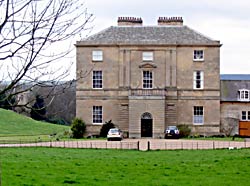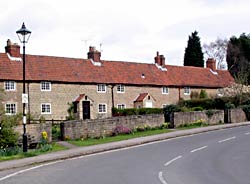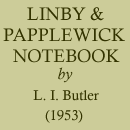< Previous | Contents | Next >
Papplewick Hall and village

Papplewick Hall dates from 1787 (photo: A Nicholson, 2005).
The present Hall was built or re-built in 1787 for the Hon. Frederick Montagu, who was Lord of the Treasury, and lived here for about thirteen years. It was this Montagu who tried to abolish the fast day of Charles the Martyr, and who helped to prepare the impeachment of Warren Hastings (Mee). He was a friend of the poets Gray and Mason, to whom he erected monuments in the woods near the Hall: and he was a great planter of trees naming the plantations after the different commanders at naval victories. Amongst these are the Nelson (1 Aug. 1798), the Warren (13 Aug. 1798), the Vincent (14 Feb. 1797), the Howe (1 June 1794), and the Duncan (1797), marking the date of planting on a series of obelisks. He also built the George III monument near the Waterworks by Papplewick Forest Farm. Of these the George III, and Warren are broken down, and the Duncan has disappeared.
The Hall is an example, though by no means the best, of the work of the Adams brothers, and was built on the site of a much older residence. An old sketch shows the previous house to have had a turret, which may explain the diarist Evelyn's remarks on an "incomparable vista with a pretty castle nere it"
Whether the old building went back to the time of the Newstead Canons can only be a matter of conjecture; but it might be that here was the guest house for the Priory, or a development of an ancient hostelry, or even the missing "Rectory" where the Canons serving the cure may have lived.
Mrs. Delany, writing in 1756, says, "Papplewick is much improved since I saw it, but they have no garden, only a fine field (which was divided into ten); they have taken away the hedges and only left the best of the trees here and there which did not too much intercept their view, which is a fine one .... Mr. Montagu keeps the walks pared and rolled quite round the field, at the bottom of which runs the river Lean, a very pretty brook that runs briskly and forms two or three cascades as it winds .... and in the most retired part, and in view of two of the cascades, is a temple or covered seat, which I gave them a plan for 14 years ago .. . . "
Laird, in his survey of Nottinghamshire of the early XIX century quotes from Leland "and so I rode a V miles in the very woddy grounds of the Forest, and so to a Pore Streete a thoroughfare at the end of the wood." Laird puts a footnote "This seems to be Papplewick."

Row of cottages in Papplewick (photo: A Nicholson, 2005).
While, as a village, Papplewick is not as picturesque as Linby, it lies in pleasant surroundings and maintains its rural character. It has lost a certain amount of importance by no longer being on the main Nottingham-Mansfield, or better to say the Oakham-Richmond (Yorks) road, which was the chief road until the opening of the new turnpike road in the latter half of the XVIII century. Prior to this there must have been considerable traffic through, and business in the village. A fair estimate of its business can be made by the fact that in 1675 there were issued five Recognisances to Victuallers, while Linby only had two. (Copnall. County Records). It is said to have been the old meeting place where the traders from the North met the traders from the South, and was noted for its forest sheep. A great deal of enclosure took place here, without Parliamentary sanction, for the purpose of sheep rearing; and it is said that Seven Mile House, on the outskirts of the parish, was built by the inhabitants for the prevention of the sheep straying to Arnold.
One of the occupants of Papplewick Hall after the Montagus was Squire Walters, a proprietor of the Times, who lived there for about thirty years. He made a record of some facts about the neighbourhood, and through the courtesy of the late C. W. Gray, Esq., extracts have been made available.
Extracts from Squire Walker's notes
"The old road past the Hall was found in making the the rhododendron beds. A man named Revell of Mansfield stabbed a man in the Public House where the yew tree now is, and rode to the gallows in his own coach.
There were four miles of walks round Papplewick in Miss Fountaine's time. There was a cottage called the London Lads (100 of them) Cottage near the Mill, often ran away. Some of the children lived when I came here.
The high road Linby to Papplewick went through the large field, formerly three or four fields (some in plough) and then up the screed, along side of the Churchyard and up the present footpath from Papplewick Church to the Village. The present highroad from Papplewick to Linby, made by Mr. Robinson, was a road similar to Watery Lane leading past Hardstaff's.
About forty or fifty houses were totally pulled down, near the Mills, about fourteen years ago. (i.e. 1859).
About thirty two roads have been stopped up in Linby. Wighay was all open. A Byron once lived in Hardstaff's house; then came the Stanhopes, and Lancaster, our wainer says Lord Stanhope was worried by a wolf." (Note. In 1772 the Rt. Hon. William Wyndham in his diary has the following entry. "Mr. and Mrs. Jephson told me that Lord Chesterfield used to keep a great sharp nosed dog called Loyola of which he and his wife were preposterously fond, that used to keep all their company in continual danger. He once flew at Mr. Stanhope's, Lord Chesterfield's son as he was leaning against his mother's chair in the dining room, and tore a great piece out of his breast." Can this be the origin of the fable?) Until the last century the village pound remained, and also the stocks near the Griffen's Head, but they and an old yew tree (mentioned in Walters' notes above) known affectionately as Old Peter, have disappeared in the course of time.
Robin Hood's Stable (Ordnance Survey), a cavern in the grounds of "The Hermitage," has been thought to be one of the old rock cells of a hermit; and that through this the village got its name. (From the Norse, PAPIL a priest).
In his book on Nottingham Castle, H. Gill speaks of a meeting between Henry II and Eustace, the holy hermit of Papplewick, a meeting which he says resulted in the founding of Newstead, called thus to distinguish it from the Old Stead in Longdale.
Dovecotes
There are two dove or pigeon cotes which are worthy of mention, one at Linby (Hall Farm), and the other at Papplewick (Forest Farm).
The one at Hall Farm has nesting boxes from floor to roof, and its walls are two and a half feet thick. It has over five hundred boxes, the distance between each made by a stone about thirteen inches wide, and the ledges are four and a half inches wide formed by stones three inches thick. The boxes vary in size, some being eight inches square and twelve inches deep: while the others are seven inches high, six inches wide, and eighteen inches deep. This pigeon house in all probability dates back to the time of the original hall. All the boxes and ledges are of dressed stone.
The dovecote at Forest Farm was built in the last century by Curtis Machin, and in his book on the dovecotes of Nottinghamshire Whittaker says that this was the last great dovecote built in the county and probably in the country. It has three hundred and seventy nesting boxes of uniform size. It has fourteen entrance holes, fourteen inches apart, and nine inches between rows. The ledges are fives inches wide.
